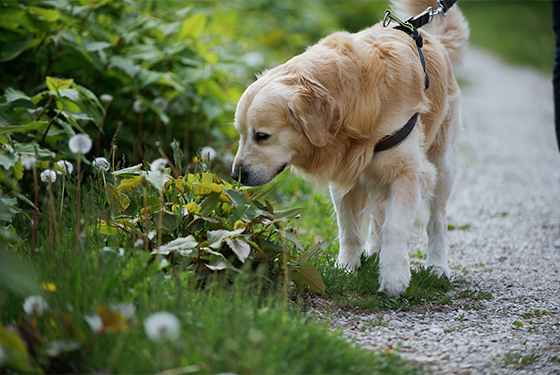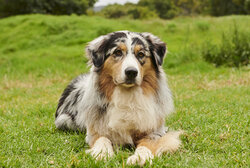Insect stings and bites in dogs
When a dog has been stung by an insect, it will often give out a sudden yelp, lick the affected area conspicuously or limp. Most wasp and bee stings are harmless, but sometimes they can be life-threatening. Here, it is important to act quickly.
What does an insect sting look like on a dog?
Just like with humans, an insect sting is mostly noticeable in the form of redness and swelling, but also itching. Under a dog’s coat, a sting is difficult to locate. However, because the coat provides relatively good protection, it is fairly rare for dogs to get stung here. Dogs are more susceptible to insect stings on their stomachs and other less hairy parts of their bodies, such as their heads. They may also be stung on their paws. Here, as well, it is difficult to locate the position of the sting. It can be dangerous when dogs snap at insects and get stung in their mouths. If the insect is a bee, the stinger and venom sac will remain in the skin. Wasps, female bumblebees and hornets, on the other hand, withdraw their stinger from the wound and are able to sting several times. Usually, however, they will flee after one attack.
The symptoms of an insect sting or bite
If it is merely a mosquito bite, it may itch a little, but at most it will manifest itself as a small red dot. The situation is different with a wasp sting. This can cause much more pronounced symptoms:
- Reddening around the puncture site
- Possibly distinct swelling
- Severe itching
- Yelping in pain
- Limping if stung on the paw
- Licking the puncture site
- Nausea and vomiting
- Shortness of breath if stung in the nose or mouth

What to do in the event of an insect sting
No matter whether it is a sting from a wasp, a bee or a hornet – it will usually be relatively harmless. If you can locate the position of the sting, check to see if the stinger is still in the skin. If this is the case, you should pull it out with, for example, a pair of tweezers. However, be careful not to crush the venom sac, because this could make the symptoms worse. If you do not have any (pointed) tweezers with which to do this, use a (butter) knife or a nail file to scrape away the sting.
In the case of a wasp sting, you will not be able to see anything at first, but fairly soon a minor swelling and reddening will often appear. If the sting does not seem to be bothering your dog and it is behaving normally, you do not need to take any action. But to be on the safe side, keep an eye on your pet for a while to make sure that everything is all right.
If the sting appears to be causing severe itching, you can use onions as a natural remedy (that will also work on humans). Cut them open and then cut them into a grid shape. This will allow the onion juice to seep out. It has a cooling and mildly disinfecting effect. The same applies to Fenistil. You can also use this if your dog has been stung by a wasp or another insect.
Possible dangers from insect stings
It is estimated that 95 percent of all insect stings in dogs are harmless and do not require a visit to the vet. There are, however, cases where this is urgently recommended.
Firstly, this concerns insect stings in the mouth, throat, neck or tongue. Swelling of the puncture site can lead to breathing difficulties and suffocation symptoms. If you suspect that your dog has been stung in one of these places, or if you have observed this, you should not let your dog out of your sight for the time being. It is, however, important to keep calm, because your dog will otherwise sense your anxiety and also become frightened. If possible, cool the area around the puncture site with a cold pack or an ice pack wrapped in a cloth. If the sting is inside the mouth, you can try to cool the area with an ice cube to suppress the swelling as far as possible. If this does not work and your dog is displaying changes in behaviour (agitation, restlessness, increased salivation or panting), take it to the vet immediately.
The second major source of danger from insect stings is an allergic reaction. This is very rare, but cannot be ruled out. In such cases, the sting results in anaphylactic shock. Symptoms can include both shallow and rapid breathing, trembling, staggering, fever and fatigue. If you suspect that your pet is experiencing an anaphylactic shock, every minute counts. Take your dog immediately to your vet or the nearest veterinary clinic. If the suspicion that your pet is allergic to insect stings is confirmed, then you should in future always carry emergency medication with you.
Prevent insect stings wherever possible
The risk of being stung by wasps and other insects is particularly high in summer and autumn. The colonies have then reached their full size and they are particularly numerous. You can never completely prevent your pet from being stung. Your dog only has to lie down in a field where there is a bee and it will sting your pet. There are, however, ways to reduce the risk of your dog getting a sting. These primarily involve the increased danger of being stung in the area of the mouth. Forbid your dog from snapping at insects right from the start, even if they are just flies. Say “No!” or “Drop it!” clearly and immediately if you observe this behaviour. In this respect, it is also advantageous if you avoid training your dog to catch treats that you have thrown in the air.
When it comes to food, it is better not to feed your dog outside, as this can attract insects. The same applies if your pet has been given wet food indoors and has not eaten it all. It is better to remove it. Also, check your dog’s water bowl every now and then, because insects may fall into it and pose a danger to your pet.
You may also like this

Removing ticks
Ticks should be removed as soon as possible

Dangerous food for your dog
You should not give these food items to your dog

Allergies in dogs
Common allergies and treatment options

Fever in dogs
What to do if your dog has a high temperature and feels poorly

